Abstract
In Houston, some of the highest measured 8-hr ozone (O3) peaks are characterized by sudden increases in observed concentrations of at least 40 ppb in 1 hr, or 60 ppb in 2 hr. Measurements show that these large hourly changes appear at only a few monitors and span a narrow geographic area, suggesting a spatially heterogeneous field of O3 concentrations. This study assessed whether a regulatory air quality model (AQM) can simulate this observed behavior. The AQM did not reproduce the magnitude or location of some of the highest observed hourly O3 changes, and it also failed to capture the limited spatial extent. On days with measured large hourly changes in O3 concentrations, the AQM predicted high O3 over large regions of Houston, resulting in overpredictions at several monitors. This analysis shows that the model can make high O3, but on these days the predicted spatial field suggests that the model had a different cause. Some observed large hourly changes in O3 concentrations have been linked to random releases of industrial volatile organic compounds (VOCs). In the AQM emission inventory, there are several emission events when an industrial point source increases VOC emissions in excess of 10,000 mol/hr. One instance increased predicted downwind O3 concentrations up to 25 ppb. These results show that the modeling system is responsive to a large VOC release, but the timing and location of the release, and meteorological conditions, are critical requirements. Attainment of the O3 standard requires the use of observational data and AQM predictions. If the large observed hourly changes are indicative of a separate cause of high O3, then the model may not include that cause, which might result in regulators enacting control strategies that could be ineffective.
To show the attainment of the O3 standard, the U.S. Environmental Protection Agency (EPA) requires the use of observations and model predictions under the assumption that simulations are capable of reproducing observed phenomena. The regulatory model is unable to reproduce observed behavior measured in the observational database. If the large observed hourly changes were indicative of a separate cause of high O3, then the model would not include that cause. Inaccurate model predictions may prompt air quality regulators to enact control strategies that are effective in the modeling system, but prove ineffective in the real world.
Introduction
In 2010, the state of Texas proposed policies aimed at reducing ozone (O3) concentrations in Houston. These policies are described and justified with modeling and observational data in a document called the State Implementation Plan (SIP) (CitationTexas Commission on Environmental Quality [TCEQ], 2010a), which follows the U.S. Environmental Protection Agency (EPA) attainment methodology (CitationEPA, 2007). The EPA attainment methodology describes the use of observational and modeling data to show attainment, and the assumptions underlying it have been the focus of several studies (CitationJones et al., 2005; CitationSistla et al., 2004; CitationVizuete et al., 2010, CitationVizuete et al., 2011). Specifically for Houston, researchers have found that the metrics used in the attainment methodology were influenced by large hourly changes in observed O3 concentrations. In the observational data used by the 2010 SIP, it has been shown that some of the highest 8-hr O3 levels included hourly changes in O3 concentrations of at least 40 ppb, or 60 ppb in 2 hr (CitationVizuete et al., 2011). These large hourly changes usually appear at only a few monitors spanning a narrow geographic area. The observed large hourly changes are the result of a plume of higher O3 being advected to the monitor site. These observations suggest high spatial heterogeneity in O3 concentrations across Houston.
Using observational data collected by regulatory monitors from 2000 to 2009, days were identified on which there was an hourly change in O3 concentrations of at least 40 ppb, or 60 ppb in 2 hr. These larger-than-typical hourly changes are called “non-typical” O3 changes, or NTOCs. In , all regulatory measurements made during 2000–2009 are separated into two categories, days on which a NTOC was measured and days on which only typical O3 changes were observed. Shown are the distributions of measured 1-hr and 8-hr O3 daily maximum concentrations. It is clear from that NTOC days have higher peak 1-hr and 8-hr O3 concentrations than typical days. The greatest 1-hr peak measured on NTOC days is 229 ppb; 1-hr peaks on typical days never reached 170 ppb. The 25th, 50th, and 75th percentile values are also substantially different. The median peak 1-h O3 value for NTOC days is 107 ppb, 66 ppb greater than for typical days. Data from daily maximum 8-hr O3 concentrations show the same trend. The median peak 8-h concentration for NTOC days is 79 ppb, more than 45 ppb greater than for typical days, and at 145 ppb the greatest peak 8-hr value is about 15 ppb greater for NTOC days than typical days. In fact, the six greatest peak 8-hr O3 values recorded between 2000 and 2009 occurred when a monitor was impacted by a NTOC. Overall, nearly 60% of all NTOC days exceeded the 8-hr O3 National Ambient Air Quality Standard (NAAQS; 0.08 ppm), but just 1% of typical days exceeded the federal limit. Probability density functions for all daily maximum 8-hr O3 from 2000 to 2009 are shown in Only measurement data from May through October are shown. The figure also shows which 8-hr O3 concentrations were measured on days including an hourly change that would be considered a NTOC. All observed 8-hr O3 values above 131 ppb were from NTOC days. The typical O3 change days dominate all 8-hr maxima below 20 ppb, but do extend well above the 85 ppb O3 standard. Thus, it is critical to understand the cause of NTOCs.
Figure 1. Distributions of observed daily maximum 1-hr (left) and 8-hr (right) O3 concentrations at all regulatory monitors from 2000 to 2009. The data are separated into typical and non-typical days. A typical O3 change day has observed 1-hr changes in O3 concentration of less than 40 ppb, or 2-hr changes less than 60 ppb. A non-typical O3 change day has a 1-hr change of at least 40 ppb, or a 2-hr change of at least 60 ppb. The 25th, 50th, and 75th percentile concentrations are represented by the box bottom, middle, and top.
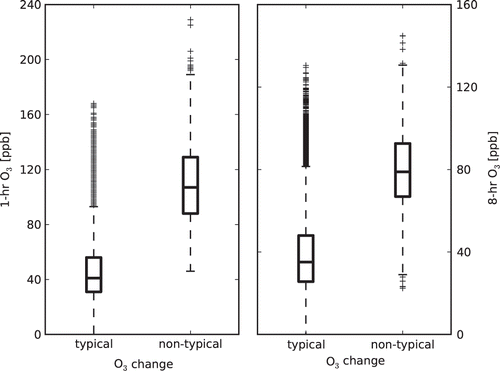
Figure 2. Distributions of observed daily maximum 8-hr O3 concentrations at all regulatory monitors from 2000 to 2009. Only measurement data from May to October are shown (n = 46,000 monitors-days). The black columns are daily maximum 8-hr O3 concentrations that were measured on days that had a non-typical O3 change (NTOC), i.e., an observed O3 change of at least 40 ppb/hr, or 60 ppb/2 hr (n = 916 monitors-days). The gray columns are 8-hr O3 concentrations that did not include an observed NTOC (n = 45,084 monitors-days).
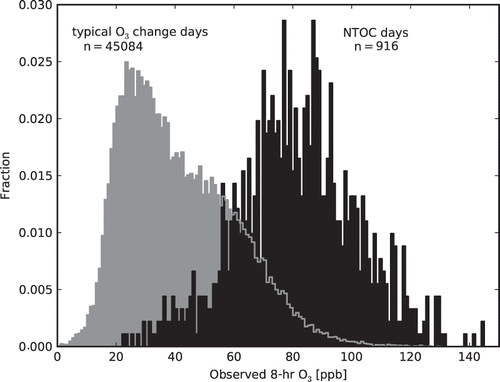
The exact cause of all observed NTOCs is still an open question and a challenge to answer given the available data. There is considerable evidence, however, that has linked some observed NTOCs to short-term releases of ethene, propene, butene isomers, and 1,3-butadiene (collectively called highly reactive volatile organic compounds [HRVOCs]). Observed NTOCs at monitor sites show coincidental concentrations of HRVOCs, and back trajectories point toward industrial sources in the Houston ship channel (CitationGan and Hopke, 2003; CitationVizuete et al., 2008). Using the NTOC criteria and observational monitoring data from 2000 to 2009, it is clear that most NTOCs are observed near the ship channel region in Houston. shows all the regulatory monitors in the Houston region and indicates which monitors most frequently measure NTOCs. The circles in the figure are centered on the ship channel. The inner circle shows that less than half of the monitoring stations account for 60% of observed NTOCs. The larger circle includes seven additional monitors and accounts for 90% of NTOC measurements.
Figure 3. The location of the 25 regulatory air quality monitors used in this study. Plot (a) shows 10 years of measurements spanning 2000–2009. For those monitors that came online after 2000, data collection began on the deployment date and continued through 2009. For this time period, the inner shaded circle shows the monitors at which 60% of all non-typical O3 changes (NTOCs) were observed. The outer shaded circle covers the monitors at which 90% of all NTOCs were observed. Both circles are centered on the ship channel. Plot (b) shows the grid cell location and frequency of simulated NTOCs by the base case simulation in the 2-km modeling domain for the entire 120-day modeling episode. (Color figure available online).
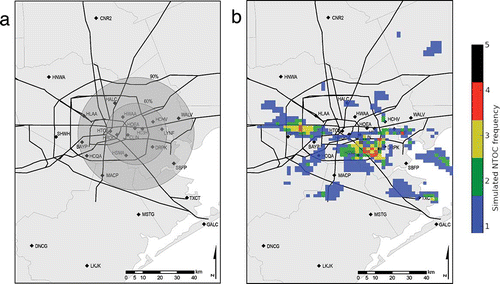
Short-term HRVOC emissions from industrial sources occur often and with notable temporal variability in Houston (CitationCowling et al., 2007; CitationMcCoy et al., 2010; CitationMurphy and Allen, 2005; CitationWebster et al., 2007; CitationWert et al., 2003). These emissions are random, and, although rare at any one facility, due to Houston's massive industrial network, there were more than 1000 releases reported in 2003 (CitationMurphy and Allen, 2005). Immediately after a release, modeling and observational evidence suggest an initial period of rapid O3 formation that results in a spatially limited downwind plume of high O3 (CitationHenderson et al., 2010; CitationKleinman et al., 2002; CitationRyerson et al., 2003; CitationXiao et al., 2010). One study found that targeted episodic HRVOC emissions from the ship channel can correct for low reactivity in models (CitationByun et al., 2007). Sensitivity to nitrogen oxide (NOx) emissions, though, was found to be small because NOx is fairly constant over time and well represented in emission inventories. By design, the largest NOx point sources (electric generating units and petrochemical facilities) operate continuously so variability in emissions tends to be small. Since NOx is a byproduct of combustion, it is unlikely that leaks or accidental releases of NOx occur. Mobile NOx sources are important to O3 formation, but evidence to support a relationship between NTOC formation and the predictable changes in NOx emissions (i.e., daily, weekly, or seasonal variability) has not been found. Furthermore, NTOCs are still observed and impacting attainment metrics despite improvements in Houston's air quality vis-à-vis NOx emissions.
To be sure, Houston's unique meteorology is a major determinant of high O3, and an emission event must meet several conditions to affect O3 concentrations. For an HRVOC release event to create a heterogeneous O3 plume, the release must have sufficient magnitude, occur in the morning, and coincide with O3 conducive meteorological conditions (CitationCzader et al., 2008; CitationHenderson et al., 2010; CitationVizuete et al., 2008). These meteorological conditions have been described in detail and are characterized at surface monitors by low wind speeds and a rotational wind field (CitationBanta et al., 2005; CitationCowling et al., 2007; CitationNgan and Byun, 2011). An analysis of winds and NAAQS exceedances in Houston, however, determined that O3 conducive meteorological conditions are necessary but insufficient to produce high O3 (CitationVizuete et al., 2009).
Distinct meteorological conditions, the stochastic nature of the emissions, and the short atmospheric lifetime of the released VOCs have provided a challenge to understand the role these emissions play in contributing to high O3 in Houston. Although data exist that links some observed NTOCs with reported or measured HRVOC emissions, a vast majority of NTOCs lack any data that can provide a causal explanation. Thus, alternative causes for observed NTOCs are still permissible. Further, observational attainment metrics used in the 2010 SIP are influenced by unexplained NTOCs. Observational metrics are only part of the EPA attainment test. The methodology also requires the use of modeling data to predict future design values for all regulatory air quality monitors. Since NTOCs are found in the observational record, this logically calls into question whether the phenomenon is adequately represented in the regulatory AQM.
Due to the magnitude and narrow spatial extent of the hourly O3 change, this phenomenon is markedly different from the “typical,” i.e., gradual, concentration changes commonly seen in other cities. Therefore, understanding the cause of these “non-typical” hourly changes becomes critical to developing an effective and defensible regulatory air quality policy in Houston. The regulatory modeling created by the CitationTexas Commission on Environmental Quality (TCEQ) in support of the 2010 SIP provides an opportunity to assess the ability of existing AQMs to simulate the heterogeneity of O3 concentrations observed in Houston. Here, the regulatory modeling created for the TCEQ's 2010 SIP is used to evaluate the ability of the AQM to simulate the spatial extent and magnitude of observed NTOC behavior and to identify any possible links to large HRVOC emissions.
Methodology
This study combines observational data measured at ground station air quality monitors and regulatory AQM predictions used by the TCEQ to support their 2010 8-hr O3 SIP. In developing the model simulations, the TCEQ followed the EPA guidance document on attaining the 8-hr O3 NAAQS (CitationEPA, 2007). All measured and simulated data are maintained by the TCEQ and available publicly (CitationTCEQ, 2010b, CitationTCEQ, 2010c).
Observational data
Observed data were obtained from the TCEQ Web site, which provides hourly averaged measurement data. Twenty-five monitoring stations were used in this study, and they are listed in with their official names, four-letter abbreviation, TCEQ identification number, and Aerometric Information Retrieval System (AIRS) number; these are the same monitors used in the TCEQ's 2010 SIP. Monitor locations are shown in
It should be noted that the observational data set spans a period (2000–2009) of substantial changes in precursor emissions. As detailed in the TCEQ's 2010 SIP, measured NOx, HRVOC, and O3 concentrations have decreased following emissions control programs. The observational data presented here may not reflect the current state of the Houston airshed, but they are significant nevertheless because they were used to formulate the latest SIP.
Air quality model data
The TCEQ used the Comprehensive Air Quality Model with Extensions (CAMx) version 4.53 (CitationENVIRON International Corporation, 2008) with the Carbon Bond V chemical mechanism and the fifth generation Penn State/National Center for Atmospheric Research (NCAR) Mesoscale Model version 3.7.3 to generate simulation data. Detailed documentation concerning the development of AQM inputs can be found on the TCEQ Web site (CitationTCEQ, 2010b). In total, there are 120 modeling days in the 2005 and 2006 episodes. A regional 36-km domain and a 12-km eastern Texas subdomain provide boundary conditions for a 4-km Houston Galveston Brazoria/Beaumont Port Arthur subdomain. A finely resolved 2-km Houston Galveston subdomain was also developed, and all analysis in this study was focused there unless explicitly stated otherwise.
The TCEQ developed, in accordance with EPA guidance, two distinct emission inventories (EIs), named base case and baseline. Using each EI, CAMx generated model predictions of O3 using identical meteorology. Model predictions made using the base case EI were used to evaluate model performance, whereas model predictions with the baseline EI were used to demonstrate attainment of the O3 NAAQS. The base case EI includes day-specific emissions, which can be highly variable in the industrial areas of Houston. The baseline EI, however, has day specificity removed and instead relies on spatially and temporally averaged emissions. According to the TCEQ's 2010 SIP documentation, the major difference between the two EIs is the representation of point source emissions. The base case uses hour- and day-specific emission rates for each emissions source, whereas baseline point source emissions are, for each hour, averaged across all simulated days. In other words, baseline point emissions for a given source have some average diurnal variation, but are identical from one day to the next. This is true for both HRVOC and NOx point sources.
provides a detailed comparison of base case and baseline hourly point source HRVOC emissions. The main plot shows hourly emission rates for the subset of point sources that are included in both inventories (not all point sources are included in both inventories). Each data point directly compares the rate in the base case to that in the baseline at a particular time and location. Points above the solid black line indicate that the emission rate was greater in the base case; points below the line indicate that the emission rate was greater in the baseline inventory. For most point sources at most times, the base case emission inventory has greater HRVOC emission rates. In a few instances, the differences are extreme. For 3 hr, one point source emitted 15,210 mol/hr HRVOC in the base case, but in the baseline inventory the emission rate is well under 500 mol/hr HRVOC. The inset plot shows distributions of hourly HRVOC emission rates at all point sources in either inventory. Though the inset is more inclusive than the main plot, it does not provide a direct hour-by-hour, source-by-source comparison of the two inventories. In the inset the major HRVOC emission rate differences are found in the upper extrema. A number of base case emission rates are greater than the maximum found in the baseline inventory, where the maximum rate is 2803 mol/hr. The maximum base case HRVOC emission rate is 82,660 mol/hr. Analysis of NOx point sources also showed greater variability in the base case inventory, but the magnitudes of the differences between the base case and the baseline were much smaller. The maximum base case NOx emission rate is 21,903 mol/hr, and the maximum rate in the baseline is 10,472 mol/hr.
Figure 4. Comparison of base case and baseline hourly point source HRVOC emissions. The main plot shows hourly emission rates for the subset of point sources that are included in both inventories (not all point sources are included in both inventories). Each data point directly compares the rate in the base case to that in the baseline at a particular time and location. The solid black line shows where the emission rates in the two emission inventories are equivalent. The inset plot shows distributions of hourly HRVOC emission rates at all point sources in either inventory. Though the inset is more inclusive than the main plot, it does not provide a direct hour-by-hour, source-by-source comparison of the two inventories. (Color figure available online).
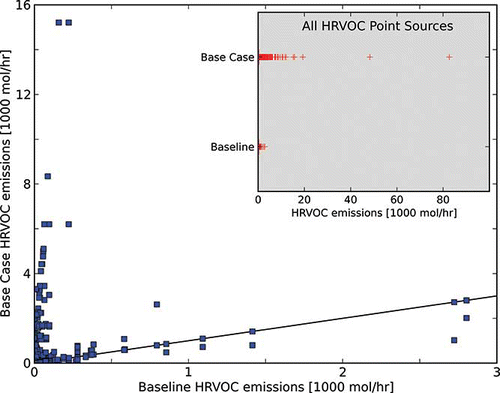
The base case EI is the most accurate representation of a historical episode with hourly variability including reported industrial releases of HRVOCs. Further, considerable resources were used by the TCEQ to increase accuracy of industrial point source emissions. This included the development of an hourly special inventory that was based on reports from 141 facilities in Houston during the period of August 15 to September 15, 2006. The baseline EI does not include the data from the special inventory. Thus, this analysis focuses primarily on predictions made using the base case EI and whether it can replicate observed NTOC behavior.
Specifically for this study, a 1-km subdomain was nested within the 2-km subdomain, and the model was rerun for the special inventory period in 2006. Meteorological inputs for the 1-km subdomain were not created, but rather interpolated by CAMx from the 4-km subdomain. Gridded emission inputs were interpolated from the 2-km subdomain, whereas point source emissions retained their specific geographic location. It has been found previously that horizontal grid resolution can affect peak O3 formation immediately following an imputed HRVOC emission event (CitationHenderson et al., 2010). Considering that many of the O3 plumes resulting from NTOCs are spatially heterogeneous and believed to be related to HRVOC emissions, it is important to consider the effect of horizontal grid resolution on hourly O3 increases. The results from the 1-km resolution sensitivity analysis can be found in the last subsection of Results.
HRVOCs are not explicitly represented in the chemical mechanism. To obtain an estimate, the sum of the Carbon Bond V species ETH (ethene), OLE (olefins), and IOLE (internal olefins) was used.
Results
Investigation of the regulatory model begins by characterizing the frequency, magnitude, and spatial distribution of predicted NTOCs. In this study, the NTOC is a metric that only indicates a gradient in O3 concentrations. An O3 change in a grid cell is described as a NTOC if (1) the change in O3 from hour to hour is equal to or greater than 40 ppb, or (2) the change in O3 over 2 hr is equal to or greater than 60 ppb.
The following analysis first quantifies the frequency and magnitude of NTOCs in the 120-day modeling episode from both the regulatory model and surface monitors. The days with a predicted NTOC are then classified as either having an upwind industrial emission or not. Representative days from each classification are then studied in closer detail and evaluated against observational data from the regulatory monitors. All analysis was restricted to the 2-km modeling domain and all predictions are from the base case emission inventory unless otherwise noted.
Predicted and observed non-typical ozone changes
During the 2005 and 2006 modeling episode, a NTOC was predicted at 672 grid cells on 22 days using the base case EI. In the simulation with the baseline EI, there were 460 grid cells over 17 days that predicted a NTOC. lists the 22 days in the base case simulation that had a NTOC, and the daily maximum 1-hr and 2-hr O3 changes for that day. Also listed are the daily maximum 1-hr and 2-hr O3 changes in the baseline simulation for the same day. The base case simulation predicted a maximum hourly O3 change of 54 ppb on September 12, 2006, and the baseline simulation predicted a maximum of 50 ppb on October 9 and August 20 of 2006. The maximum predicted change over 2 hr was 76 ppb with the base case simulation, and 74 ppb with the baseline. The only difference in these two simulations is the emission inventory, meaning that the differences in frequency and magnitude of NTOCs are the result of the removal of variable emissions. For the remainder of the evaluation, focus shifts to the base case simulations and the 22 days when a NTOC was predicted.
Table 1. Simulated maximum 1-hr and 2-hr O3 changes that met non-typical O3 change (NTOC) criteria at any grid cell in the 2-km domain using the model's base case and baseline emission inventories
Table 2. The 25 regulatory air quality monitors used in this study
The base case simulation predicted NTOCs for 22 days and during the same episode time frame there were 87 observed NTOCs over 36 days. In these two sets of data, only 9 days had both a predicted and observed NTOC, and they are in boldface in Thus, the AQM was unable to reproduce the observed phenomenon on 27 of the 36 days. The maximum observed hourly O3 change was 62 ppb at the TXCT monitor at 10:00 a.m. on June 9, 2006. On this day the base case simulation underpredicted the hourly O3 change at TXCT by 46 ppb and the 1-hr concentration by over 40 ppb. The maximum observed 2-hr change was 95 ppb at the HROC monitor at 11:00 a.m. on August 1, 2005. On this day the base case simulation underpredicted the 2-hr O3 change at HROC by 48 ppb, but correctly predicts the 1-hr concentration. Recent analysis from the 2009 Study of Houston Atmospheric Radical Precursors showed that a photochemical box model did not simulate O3 production rates greater than 35 ppb/hr during high O3 episodes, though measured rates were often between 40 and 80 ppb/hr (CitationCazorla et al., 2011), which suggests the underpredictions in the regulatory AQM are at least partly due to chemistry.
Distributions of observed daily maximum 8-hr O3 concentrations at all monitors during the modeling episode time frame are shown in . shows base case simulated daily maximum 8-hr O3 concentrations from all grid cells where the monitors are located. The black columns are 8-hr O3 concentrations from days that had a NTOC, and gray columns show data from days without a NTOC. Similar to the distribution using 10 years of data shown in , the highest frequency of 8-hr values with a NTOC occurred at 88 ppb in the observations. The model predicted 8-hr averages in excess of 140 ppb, though the peak observed 8-hr max was 127 ppb.
Figure 5. Similar to , but limited to the days during the 120-day modeling episode for the base case simulation. Plot (a) shows distributions of observed daily maximum 8-hr O3 concentrations at all monitors for days that coincided with the modeling episode (n = 3000 monitors-days). The black columns are the concentrations that were measured on days that had a non-typical O3 change (NTOC), i.e., an observed O3 change of at least 40 ppb/hr, or 60 ppb/2 hr (n = 916 monitors-days). Plot (b) shows distributions of simulated daily maximum 8-hr O3 concentrations at all grid cells where the regulatory monitors are located (n = 2400 grid cell-days). Here, the black columns are concentrations that were predicted on days that had a simulated NTOC. Twenty-four modeling days had incomplete data and are excluded from this plot.
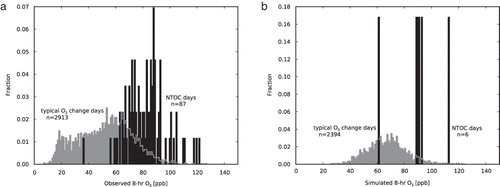
During the modeling episode, the DRPK, WALV, and LYNF monitors—all located in the ship channel region—observed the greatest number of NTOCs. August 17, 2006, had the greatest number of monitors (seven) that measured a NTOC, though most days had far fewer NTOC measurements. Approximately 75% of the days had observed NTOCs at three or fewer monitors, and 89% of the days had observed NTOCs at four or fewer monitors. When NTOCs were measured at multiple locations, the monitors were often in close proximity to each other, indicating that NTOCs occur over a small spatial scale.
shows the locations and frequency of predicted NTOCs during the 120-day modeling episode. The maximum number of predicted NTOCs for a given grid cell was five; most grid cells had no predicted NTOCs. Simulated NTOCs were most frequent in the ship channel region, which is consistent with measurements shown in . At each hour, there may be more than one grid cell with a simulated NTOC. For hours when a NTOC was simulated, the median number of grid cells simulating the NTOC is five. The maximum number of grid cells to predict a NTOC at the same time is 59.
Predicted non-typical ozone changes and industrial emissions
The previous section identified simulation days in the base case when and where a NTOC was predicted. This section investigates whether simulated large industrial emission releases also coincided with a predicted NTOC. In the base case EI, there were six hourly changes of HRVOC emissions in excess of 10,000 mol/hr. Only two of these large increases in HRVOC emissions resulted in a predicted NTOC. The remaining large releases of HRVOCs occurred at night, and had little impact on predicted O3 concentrations.
Only 2 of the 22 days with predicted NTOCs () also had an upwind release of HRVOCs greater than 10,000 mol/hr. The largest increase in O3 concentrations resulting from a release was on August 20, 2006. On this day there was a predicted 1-hr increase in HRVOC emissions from 5:00 a.m. to 6:00 a.m. of 32,643 moles. A black “X” in marks the location of the emissions increase. The emissions release occurred early in the morning, providing a sufficient number of daylight hours to process and contribute to downwind O3 formation. Further, the location of the emission release is in the Houston ship channel, a common origin of observed O3 plumes. This HRVOC release is not included in the baseline EI, thus providing a natural sensitivity run for the release on O3 concentrations. Ground layer 1-hr O3 values from the baseline simulation were subtracted from the O3 values predicted using the base case EI as shown in The HRVOC emissions were released at 6 a.m. () and then carried south where the predicted increase in O3 concentrations was 25 ppb greater than in the baseline prediction at 8 a.m. () and was spatially limited covering only a few kilometers. This result confirms the model's ability, under the right conditions, to predict an O3 plume with a limited spatial extent.
Figure 6. Spatial plot showing simulated 1-hr O3 differences at (a) 6:00 a.m. and (b) 8:00 a.m. on August 20, 2006. The values were obtained by subtracting the baseline O3 predictions from the base case O3 predictions. The location of the DRPK monitor is marked by a black diamond. An HRVOC emissions event occurred in the base case EI at 6:00 a.m. in the grid cell marked with a black “X.” (Color figure available online).

The DRPK monitor was the closest monitor to the location of the large O3 increase, and its location is labeled in A time-series plot of observed and simulated 1-hr O3 concentrations is shown in The DRPK observations on this day showed a rapid increase from 3 ppb at 6:00 a.m. to 46 ppb in just 2 hr. Predicted values at 8:00 a.m. were 51 ppb with the base case EI and 26 ppb with the baseline EI. The two model runs have nearly identical O3 predictions except from 6:00 a.m. to 9:00 a.m., which was immediately after the HRVOC release. During those hours, the base case O3 concentrations are greater than in the baseline simulation. It is clear that model performance improved on this day with the inclusion of the HRVOC release. It is unclear, however, if the measured increase at DRPK was the result of an emission release. Nevertheless, the model is capable of increasing O3 concentrations under O3 conducive meteorology if the HRVOC emissions are placed with sufficient magnitude at the right location and time.
Figure 7. Observed and simulated 1-hr O3 concentrations on August 20, 2006, recorded at the DRPK monitor. Simulated O3 concentrations are nearly identical for both the base case and baseline simulations except for the 3 hr immediately following the HRVOC release (6:00 a.m.) in the base case simulation.
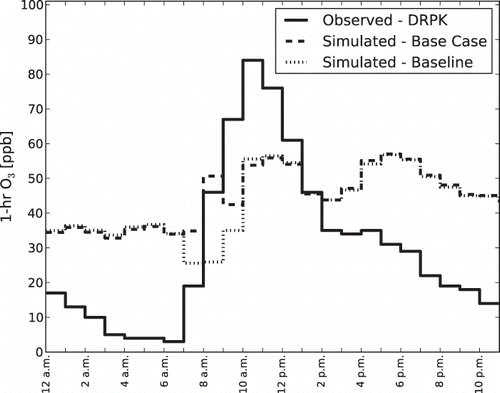
Predicted non‐typical ozone changes without industrial emissions
There are 20 simulation days with a predicted NTOC and no simulated upwind release of HRVOC emissions greater than 10,000 mol/hr. All 20 days exhibited similar behavior, and two representative days—August 1, 2005, and August 17, 2006—are analyzed here. On August 1, 2005, the model predicted a NTOC of 51 ppb/hr at 9:00 a.m. in Texas City (southeast of central Houston), and a second NTOC of 46 ppb/hr at 12:00 p.m. near the BAYP monitor. The maximum observed hourly O3 change for this day was 56 ppb/hr located at BAYP. shows, for 9:00 a.m. to 12:00 p.m., the simulated ground layer 1-hr O3 concentrations (grid cells) for the modeling domain overlaid with measurements from the air quality monitors (diamond markers). A mismatch between the colors of the diamond marker and surrounding grid cells indicates an under- or overprediction by the AQM. If no measurement data are available, the marker is a black dot. At 10:00 a.m., a simulated plume of high O3 greater than 90 ppb covers much of southern Houston, but very few monitors measured values above 90 ppb. By 11:00 a.m., simulated concentrations reach 136 ppb and begin to move westward. Much of southwestern Houston has reached a predicted O3 value of at least 120 ppb, but only three monitors (CLIN, HROC, and HSMA) had triple-digit concentrations. Model overpredictions continued into the next hour, where predicted concentrations reached 168 ppb. A number of grid cells to the southeast and west of central Houston predicted a NTOC, and they are marked with a black “X” in The NTOC predictions occurred the edge of a plume with the highest O3 values.
Figure 8. Spatial plot showing predictions from the base case simulation of 1-hr O3 concentrations at (a) 9:00 a.m., (b) 10:00 a.m., (c) 11:00 a.m., and (d) 12:00 p.m. on August 1, 2005. The diamond markers show measurement data from air quality monitors; if no data are available, the marker is a black dot. Color mismatches between the diamond markers (measurements) and grid cells (simulations) indicate model over- or underpredictions. Gray arrows show the simulated wind vectors at select grid cells. Arrows originating at the center of a diamond marker show measured wind data. Simulated NTOCs are marked with a black “X” (9:00 a.m. and 12:00 p.m. only). (Color figure available online).
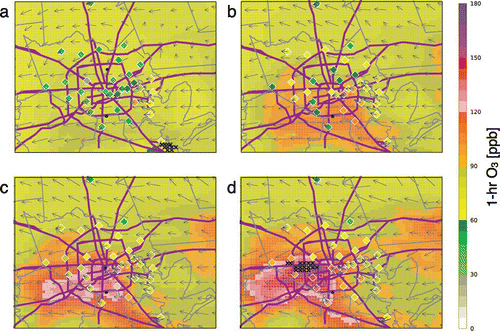
On August 1, 2005, at 12:00 p.m., the model predicted 1-hr O3 concentrations in excess of 120 ppb, but observations show that only the BAYP monitor recorded O3 levels of that magnitude (). compares observed and simulated O3 concentrations at 12:00 p.m. for all monitors near downtown Houston that were impacted by the simulated high O3 plume. The overpredictions at HCQA and SHWH are 37 and 56 ppb, respectively. The peak observed 1-hr O3 concentration at BAYP—140 ppb—came immediately after a 1-hr change of 56 ppb, but the simulated high O3 at BAYP was not the result of a NTOC; a NTOC was predicted 10 km from the monitor. As shown in , the maximum simulated hourly change at BAYP was only 23 ppb. Simulated concentrations overpredict measurements by approximately 50 ppb at 10:00 a.m. and 11:00 a.m., but that overprediction is only 10 ppb at 12:00 p.m. after the observed 1-hr increase of 56 ppb.
Figure 9. (a) Observed and simulated (base case EI) 1-hr O3 concentrations at 12:00 p.m. on August 1, 2005. (b) Observed and simulated 1-hr O3 concentrations on August 1, 2005, recorded at the BAYP monitor. A 1-hr increase of 56 ppb was measured at 12:00 p.m.
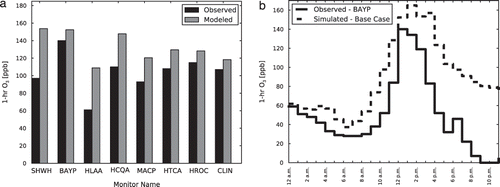
When the regulatory AQM does make a prediction that meets some of the NTOC criteria at a monitor, it does so over a large spatial area and does not reproduce the observed limited spatial scale of high O3 seen in monitor measurements. For example, shows for August 17, 2006, the model predicted values from a grid cell 5 km from the DRPK monitor. shows that model predictions had similar changes in hourly concentrations and nearly matched the peak 1-hr O3 measured at the DRPK monitor. The model does not, however, reproduce the narrow spatial extent of high O3 as observed by the monitors. As shown in , the model predicts a high O3 plume in the southern part of the Houston urban core at 2:00 p.m., causing an overprediction at the majority of the monitors in that region. shows the amount of overprediction at 2:00 p.m. at five regulatory monitors. Although the model predictions match peak measurements at the HSMA monitor, the model overpredicts O3 concentrations at all other monitors and by more than 40 ppb at the SHWH monitor. On this day the model is able to reproduce observed phenomena at one monitor, but does so over too large a spatial extent. For many of the days where an observed NTOC is measured at a monitor, the model does not reproduce the hourly values or the limited spatial extent of the observed high O3.
Figure 10. Observed and simulated (base case EI) 1-hr O3 concentrations on August 17, 2006. Observations were recorded at the DRPK monitor. Simulated values were extracted from a grid cell 5 km away from DRPK. A NTOC was measured and simulated at 11:00 a.m.

Figure 11. Plot (a) is a spatial plot showing simulated (base case EI) 1-hr O3 concentrations at 2:00 p.m. on August 17, 2006. The diamond markers show measurement data from air quality monitors. Color mismatches between the diamond markers (measurements) and grid cells (simulations) indicate model over- or underpredictions. Gray arrows show the simulated wind vectors at select grid cells. Arrows originating at the center of a diamond marker show measured wind data. Plot (b) shows observed and simulated (base case EI) 1-hr O3 concentrations for select monitors. (Color figure available online).
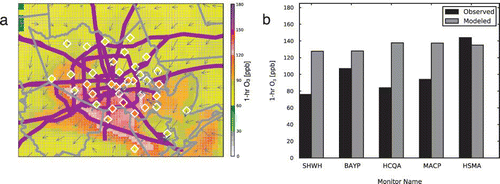
These data show that the model can make high O3, but the causes in the model are likely not the same causes for producing high O3 in the observations. The cause of highest O3 in the observations is spatially and temporally limited, and not like those predicted by the model.
Effect of horizontal grid resolution on non-typical ozone changes
Maximum 1- and 2-hr O3 changes were 65 ppb/hr and 78 ppb/2 hr when the model was rerun with the nested 1-km subdomain. Compared with the 2-km subdomain simulation, the maximum 1-hr change increased by 20% (11 ppb) and the maximum 2-hr change increased by 3% (2 ppb). Grid resolution, therefore, impacts the magnitude of hourly O3 increases. Although the 2-km subdomain is generally considered to be finely resolved, it may be too coarse to simulate the magnitude of the observed NTOC phenomenon.
It was shown in the previous section that the model failed to predict the spatially limited O3 plume on August 17, 2006, with the 2-km subdomain. Model simulations using the 1-km subdomain similarly show a large O3 plume over southern Houston. The persistence of such overpredictions suggests that horizontal grid resolution is likely not causing problems with spatial heterogeneity.
Conclusion
Analysis of Houston O3 monitoring data from 2000 to 2009 shows that on days when a monitor observed a NTOC, that monitor was also more likely to exceed the 8-hr O3 NAAQS. Thus, identifying the conditions and sources that produce a NTOC is critical to controlling O3 violations. The regulatory AQM used to support the 2010 SIP did not reproduce observed behavior on most NTOC days, and often underpredicted the hourly O3 change. Simulations also failed to capture the limited spatial extent of high O3 found on NTOC days. On these days the AQM often predicted high O3 concentrations over large regions of Houston, resulting in overpredictions at many of the monitors. Thus, a more accurate reproduction of extreme measured behavior at a handful of monitors came at the cost of misrepresenting observations elsewhere. It is important to note that this result is not considered detrimental in the current EPA attainment guidance.
Prior to 2007, the EPA required the use of observations and model predictions under the assumption that simulations were capable of reproducing the specific observed phenomena. After 2007, the attainment guidance now assumes that models only need to be capable of reproducing a change in ozone concentrations due to changes in precursor emissions, without necessarily reproducing accurately the observed base case measurements. In the current approach, the model's predicted change is applied to the base case observations to predict a future case. It is still the assumption, however, that the model with its inputs is able to simulate the critical processes driving poor air quality. If random emissions processes are indeed driving these large hourly changes in concentrations, then it is unrealistic to expect a deterministic modeling episode of just 120 days to represent this process accurately. This is especially true if the observational metrics used by the attainment process are averages of observations taken over a 5-year time period.
A necessary next step is to perform a meteorological analysis similar to the studies described above (CitationByun et al., 2007; CitationVizuete et al., 2009). It is important to understand the regional meteorology that was present on NTOC days, because high O3 in Houston is known to be dependent upon wind fields. Understanding whether winds on NTOC days are dissimilar from winds on typical days, and whether modeled winds closely match measurements, will provide key pieces of evidence for determining the cause(s) of NTOCs and model deficiencies. There is also a need for back-trajectory analysis on NTOC days to determine if air parcels that impacted ground monitors passed over industrial facilities.
The modeling presented here was performed by the TCEQ as a requirement of the O3 attainment process. This model was used to develop and defend future pollution controls and thus represents a real-world application of regulatory modeling. The goal of this study was not to “fix” the model's deficiency, but rather to evaluate model performance in an actual regulatory application. It is clear that there is an observed phenomenon in Houston whose cause may not be addressed by current EPA guidance. Once the cause is better understood, a dual approach could be proposed that would address NTOC phenomena separately from the EPA guidance. Such a dual approach has already been used in Houston and served as the technical foundation of the successful 2004 Houston 1-hr O3 SIP mid-course review (CitationTCEQ, 2004). In this SIP, random industrial emission events were addressed with targeted controls, and the regulatory model was used to formulate policy (e.g., NOx and HRVOC cap and trade programs, reductions of industrial NOx, mobile source reductions) for the remaining causes of violations. More recently, it has been suggested that peak O3 may be responsive initially to targeted ship channel VOC emissions, but further O3 reductions may require NOx limits (CitationXiao et al., 2010). This dual approach proved to be effective in reducing ozone and could be applied in current SIP efforts.
Acknowledgments
The authors thank Dr. Jim Smith and Dr. Mark Estes from the Texas Commission on Environmental Quality for providing data and guidance. Thanks are also extended to Dr. Barron Henderson, postdoc at the EPA's Atmospheric Modeling and Analysis Division (now a professor at the University of Florida), for his keen insight and technical help.
References
- Banta , R.M. , Senff , C.J. , Nielsen-Gammon , J. , Darby , L.S. , Ryerson , T.B. , Alvarez , R.J. , Sandberg , S.P. , Williams , E.J. and Trainer , M. 2005 . A bad air day in Houston . Bull. Am. Meteorol. Soc. , 86 : 657 – 669 . doi: 10.1175/bams-86-5-657
- Byun , D.W. , Kim , S.-T. and Kim , S.-B. 2007 . Evaluation of air quality models for the simulation of a high ozone episode in the Houston metropolitan area . Atmos. Environ. , 41 : 837 – 853 . doi: 10.1016/j.atmosenv.2006.08.038
- Cazorla , M. , Brune , W.H. , Ren , X. and Lefer , B. 2011 . Direct measurement of ozone production rates in Houston in 2009 and comparison with two estimation methods . Atmos. Chem. Phys. Discuss. , 11 : 27521 – 27546 . doi: 10.5194/acpd-11‐27521–2011
- Cowling, E., C. Furiness, B. Dimitriades, D. Parrish. 2007. Final rapid science synthesis report: Findings from the second Texas Air Quality study (TexAQS II)—Final report to the Texas Commission on Environmental Quality. TCEQ Contract Number 582-4-65614. http://www.tceq.info/assets/public/implementation/air/am/texaqs/rsst_final_report_pdf (http://www.tceq.info/assets/public/implementation/air/am/texaqs/rsst_final_report_pdf)
- Czader , B.H. , Byun , D.W. , Kim , S.-T. and Carter , W.P.L. 2008 . A study of VOC reactivity in the Houston-Galveston air mixture utilizing an extended version of SAPRC-99 chemical mechanism . Atmos. Environ. , 42 : 5733 – 5742 . doi: 10.1016/j.atmosenv.2008.01.039
- ENVIRON International Corporation . 2008 . CAMx Users Guide Comprehensive Air Quality Model with Extensions, Version 4.50 , Novato , CA : ENVIRON International Corporation .
- Gan , F. and Hopke , P.K. 2003 . Data mining of the relationship between volatile organic compounds and transient high ozone formation . Anal. Chim. Acta , 490 : 153 – 158 . doi: 10.1016/S0003–2670(03)00497–5
- Henderson , B.H. , Jeffries , H.E. , Kim , B.-U. and Vizuete , W. 2010 . The influence of model resolution on ozone in industrial volatile organic compound plumes . J. Air Waste Manag. Assoc. , 60 : 1105 – 1117 . doi: 10.3155/1047–3289.60.9.1105
- Jones , J.M. , Hogrefe , C. , Henry , R.F. , Ku , J.-Y. and Sistla , G. 2005 . An assessment of the sensitivity and reliability of the relative reduction factor approach in the development of 8-hr ozone attainment plans . J. Air Waste Manag. Assoc. , 55 : 13 – 19 .
- Kleinman , L.I. , Daum , P.H. , Imre , D. , Lee , Y.-N. , Nunnermacker , L.J. , Springston , S.R. , Weinstein-Lloyd , J. and Rudolph , J. 2002 . Ozone production rate and hydrocarbon reactivity in 5 urban areas: A cause of high ozone concentration in Houston . Geophys. Res. Lett. , 29 : 1467 doi: 10.1029/2001GL014569
- McCoy , B.J. , Fischbeck , P.S. and Gerard , D. 2010 . How big is big? How often is often? Characterizing Texas petroleum refining upset air emissions . Atmos. Environ. , 44 : 4230 – 4239 . doi: 10.1016/j.atmosenv.2010.07.008
- Murphy , C.F. and Allen , D.T. 2005 . Hydrocarbon emissions from industrial release events in the Houston-Galveston area and their impact on ozone formation . Atmos. Environ. , 39 : 3785 – 3798 . doi: 10.1016/j.atmosenv.2005.02.051
- Ngan , F. and Byun , D. 2011 . Classification of weather patterns and associated trajectories of high-ozone episodes in the Houston-Galveston-Brazoria area during the 2005/06 TexAQS-II . J. Appl. Meteorol. Climatol. , 50 : 485 – 499 . doi: 10.1175/2010jamc2483.1
- Ryerson , T.B. , Trainer , M. , Angevine , W.M. , Brock , C.A. , Dissly , R.W. , Fehsenfeld , F.C. , Frost , G.J. , Goldan , P.D. , Holloway , J.S. and Hubler , G. 2003 . Effect of petrochemical industrial emissions of reactive alkenes and NOx on tropospheric ozone formation in Houston, Texas . J. Geophys. Res. Atmos , 108 : 4249 doi: 10.1029/2002JD003070
- Sistla , G. , Hogrefe , C. , Hao , W. , Ku , J.-Y. , Zalewsky , E. , Henry , R.F. and Civerolo , K. 2004 . An operational assessment of the application of the relative reduction factors in the demonstration of attainment of the 8-hr ozone National Ambient Air Quality Standard . J. Air Waste Manag. Assoc. , 54 : 950 – 959 .
- Texas Commission on Environmental Quality . 2004 . Revisions to the State Implementation Plan (SIP) for the Control of Ozone Air Pollution: Houston/Galveston/Brazoria Ozone Nonattainment Area , Austin , TX : Project No . 2004-042-SIP-NR.
- Texas Commission on Environmental Quality . 2010a . Revisions to the State Implementation Plan for the Control of Ozone Air Pollution: Houston-Galveston-Brazoria 1997 Eight-Hour Ozone Standard Nonattainment Area , Austin , TX : Project No . 2009-017-SIP-NR.
- Texas Commission on Environmental Quality. 2010b. Houston-Galveston-Brazoria 8-hour ozone SIP modeling (2005/2006 episodes) http://www.tceq.texas.gov/airquality/airmod/data/hgb8h2 (http://www.tceq.texas.gov/airquality/airmod/data/hgb8h2)
- Texas Commission on Environmental Quality. 2010c. Ozone data http://www.tceq.texas.gov/agency/data/ozone_data.html (http://www.tceq.texas.gov/agency/data/ozone_data.html) (Accessed: 28 April 2010 ).
- U.S. Environmental Protection Agency . 2007 . Guidance on the Use of Models and Other Analyses for Demonstrating Attainment of Air Quality Goals for O3, PM and Regional Haze , Washington , DC : U.S. Environmental Protection Agency . EPA-454/B-07-002
- Vizuete , W. , Biton , L. , Jeffries , H.E. and Couzo , E. 2010 . Evaluation of relative response factor methodology for demonstrating attainment of ozone in Houston, Texas . J. Air Waste Manag. Assoc. , 60 : 838 – 848 . doi: 10.3155/1047–3289.60.7.838
- Vizuete , W. , Jeffries , H.E. , Tesche , T.W. , Olaguer , E.P. and Couzo , E. 2011 . Issues with ozone attainment methodology for Houston, TX . J. Air Waste Manag. Assoc. , 61 : 238 – 253 . doi: 10.3155/1047–3289.61.3.238
- Vizuete, W., H.E. Jeffries, A. Valencia, E. Couzo, E. Christoph, J. Wilkinson, B. Henderson, H. Parikh, and J. Kolling. 2009. HARC Project H97: Multi- Model, Multi-Episode Process Analysis to Investigate Ozone Formation and Control Sensitivity in the 2000/2005/2006 Houston SIP Episode Models. The Woodlands, TX: Houston Advanced Research Center. http://projects.tercairquality.org/AQR/H097 (http://projects.tercairquality.org/AQR/H097)
- Vizuete , W. , Kim , B.-U. , Jeffries , H.E. , Kimura , Y. , Allen , D.T. , Kioumourtzoglou , M.-A. , Biton , L. and Henderson , B. 2008 . Modeling ozone formation from industrial emission events in Houston, Texas . Atmos. Environ. , 42 : 7641 – 7650 . doi: 10.1016/j.atmosenv.2008.05.063
- Webster , M. , Nam , J. , Kimura , Y. , Jeffries , H.E. , Vizuete , W. and Allen , D.T. 2007 . The effect of variability in industrial emissions on ozone formation in Houston, Texas . Atmos. Environ. , 41 : 9580 – 9593 . doi: 10.1016/j.atmosenv.2007.08.052
- Wert , B.P. , Trainer , M. , Fried , A. , Ryerson , T.B. , Henry , B. , Potter , W. , Angevine , W.M. , Atlas , E. , Donnelly , S.G. and Fehnsenfeld , F.C. 2003 . Signatures of terminal alkene oxidation in airborne formaldehyde measurements during TexAQS 2000 . J. Geophys. Res. Atmos. , 108 ( D3 ) : 4104 doi: 10.1029/2002JD002502
- Xiao , X. , Cohan , D.S. , Byun , D.W. and Ngan , F. 2010 . Highly nonlinear ozone formation in the Houston region and implications for emission controls . J. Geophys. Res. Atmos. , 115 ( D23309 ) doi: 10.1029/2010JD014435